
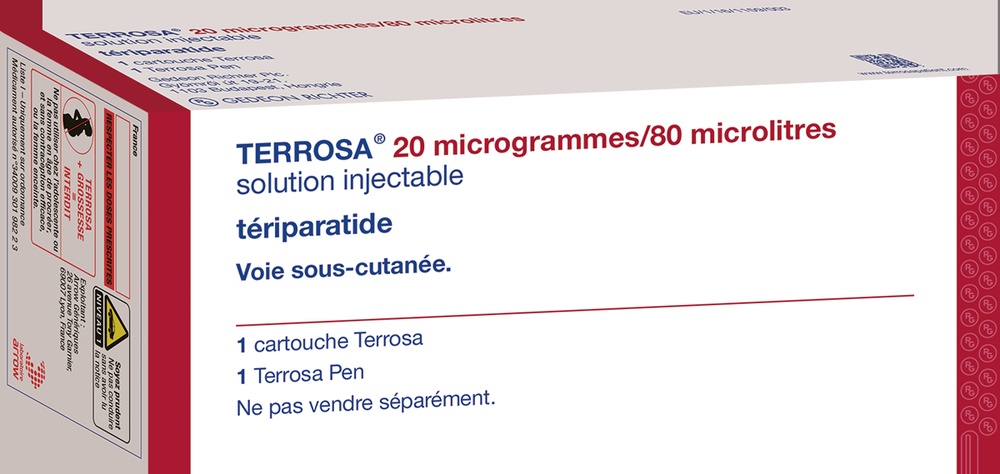
TERROSA 20 micrograms/80 microliters Injectable Solution

Ask a doctor about a prescription for TERROSA 20 micrograms/80 microliters Injectable Solution

How to use TERROSA 20 micrograms/80 microliters Injectable Solution
Introduction
Package Leaflet: Information for the User
Terrosa 20 micrograms/80 microliters solution for injection
Teriparatide
This medicine is subject to additional monitoring, which will allow for the quick identification of new safety information. You can help by reporting any side effects you may get. The last section of this leaflet includes information on how to report side effects.
Read all of this leaflet carefully before you start using this medicine, because it contains important information for you.
- Keep this leaflet, you may need to read it again.
- If you have any further questions, ask your doctor or pharmacist.
- This medicine has been prescribed for you only. Do not pass it on to others. It may harm them, even if their signs of illness are the same as yours.
- If you get any side effects, talk to your doctor or pharmacist. This includes any possible side effects not listed in this leaflet. See section 4.
Contents of the pack
- What is Terrosa and what is it used for
- What you need to know before you use Terrosa
- How to use Terrosa
- Possible side effects
- Storage of Terrosa
- Contents of the pack and other information
1. What is Terrosa and what is it used for
Terrosa contains the active substance teriparatide, which is used to increase bone strength and reduce the risk of fractures by stimulating bone formation.
Terrosa is used for the treatment of osteoporosis in adults. Osteoporosis is a disease that makes your bones wear down and become fragile. This disease is especially common in women after menopause, but it can also occur in men. Osteoporosis is also common in patients treated with medicines called corticosteroids.
2. What you need to know before you use Terrosa
Do not use Terrosa:
- if you are allergic to teriparatide or any of the other ingredients of this medicine (listed in section 6).
- if you have high levels of calcium in your blood (hypercalcemia).
- if you have severe kidney problems.
- if you have ever had bone cancer or if other types of cancer have spread (metastasized) to your bones.
- if you have certain bone diseases. If you have a bone disease, consult your doctor.
- if you have high levels of alkaline phosphatase in your blood without apparent explanation, which could indicate that you have Paget's disease of the bone (a disease with abnormal bone changes). If you are not sure, consult your doctor.
- if you have received radiation therapy that may have affected your bones.
- if you are pregnant or breastfeeding.
Warnings and precautions
Terrosa may increase calcium in your blood or urine.
Talk to your doctor before or while using Terrosa:
- If you constantly feel nauseous, vomit, are constipated, feel weak or have muscle weakness, tell your doctor. These may be symptoms of too much calcium in your blood.
- If you have kidney stones or have had kidney stones.
- If you have kidney problems (moderate renal insufficiency), you should tell your doctor.
Some patients, after the first doses of Terrosa, may feel dizzy or have an increased heart rate. For the first doses, use Terrosa in a place where you can sit or lie down immediately if you feel dizzy.
The recommended treatment time of 24 months should not be exceeded.
Before inserting a cartridge into Terrosa Pen, note the batch number (Batch) of the cartridge and the date of the first injection in a calendar. You should also note the date of the first injection on the Terrosa box (see the space provided on the box: {First use:}) (see section 3).
Terrosa should not be used in adults who are still growing.
Children and adolescents
Terrosa should not be used in children and adolescents (under 18 years of age).
Other medicines and Terrosa
Tell your doctor or pharmacist if you are using, have recently used, or might use any other medicines.
This is important because some medicines (e.g., digoxin/digitalis, a medicine used to treat heart diseases) may interact with teriparatide.
Pregnancy and breastfeeding
Do not use Terrosa if you are pregnant or breastfeeding. If you are a woman of childbearing age, you should use effective contraceptive methods during treatment with Terrosa. If you become pregnant while using Terrosa, treatment should be discontinued. Consult your doctor or pharmacist before using any medicine.
Driving and using machines
Some patients may feel dizzy after the injection of Terrosa. If you feel dizzy, do not drive or use machines until you feel better.
Terrosa contains sodium
This medicine contains less than 1 mmol of sodium (23 mg) per dose unit; it is essentially "sodium-free".
3. How to use Terrosa
Follow the instructions for administration of this medicine exactly as prescribed by your doctor. If in doubt, consult your doctor or pharmacist again.
The recommended dose is 20 micrograms (corresponding to 80 microliters) administered once a day by subcutaneous injection in the thigh or abdomen.
To help you remember to inject your medicine, inject it at the same time every day. Terrosa can be injected at mealtime. Inject Terrosa every day for as long as your doctor prescribes it. The total duration of treatment with Terrosa should not exceed 24 months.
You should not receive more than one 24-month treatment cycle in your lifetime.
Your doctor may advise you to take Terrosa with calcium and vitamin D. Your doctor will tell you how much to take each day.
Terrosa can be administered with or without food.
The Terrosa cartridges are designed for use exclusively with the reusable Terrosa Pen multidose administration system and compatible pen needles. The pen and needles are not included with Terrosa. However, for the start of treatment, a pack containing a cartridge and pen should be used, which includes a Terrosa cartridge box and a Terrosa Pen box.
Before the first use, insert the cartridge into the pen. To use this medicine correctly, it is very important that you carefully follow the detailed instructions for use of the pen provided with it.
Use a new needle for each injection to prevent contamination and safely discard the needle after use.
Never store the pen with the needle attached.
Never share your pen with others.
Do not use Terrosa Pen to inject any other medicine (e.g., insulin).
The pen is designed for use with Terrosa only.
Do not refill the cartridge.
Do not transfer the medicine to a syringe.
You should inject Terrosa shortly after removing the pen with the cartridge inserted from the refrigerator.
Put the pen with the cartridge inserted back in the refrigerator immediately after use. Do not remove the cartridge from the pen after each use. Keep it in the cartridge box during the entire 28-day treatment period.
Preparing the pen for use
- To ensure correct administration of Terrosa, always read the instructions for use of Terrosa Pen, included in the pen box.
- Wash your hands before handling the cartridge or pen.
- Check the expiration date on the cartridge label before inserting it into the pen.
Make sure there are at least 28 days left until the expiration date. Insert the cartridge into the pen before the first use as detailed in the pen instructions. Note the batch number (Batch) of each cartridge and the first injection date in a calendar.
You should also note the date of the first injection on the Terrosa box (see the space provided on the box: {First use:}) (see section 3).
- After inserting a new cartridge and before the first injection of that cartridge, prepare the pen according to the instructions provided. Do not prepare it again after the first dose.
Injecting Terrosa
- Before injecting Terrosa, clean the skin where you plan to inject it (thigh or abdomen) as your doctor has instructed.
- Gently pinch the cleaned skin and insert the needle perpendicular to the skin. Press the button and keep it pressed until the dose indicator returns to the starting position.
- After the injection, leave the needle in the skin for six seconds to ensure you receive the full dose.
- After the injection is complete, place the needle protective cap on the pen needle; screw the cap counterclockwise to remove the needle from the pen. This will maintain the sterility of the remaining Terrosa and prevent leaks from the pen. It will also prevent air from entering the cartridge again and the needle from becoming clogged.
- Put the cap back on the pen. Leave the cartridge in the pen.
If you use more Terrosa than you should
If you have accidentally administered more Terrosa than prescribed, talk to your doctor or pharmacist.
The effects that can be expected from an overdose include nausea, vomiting, dizziness, and headache.
If you forget to use Terrosa
If you miss an injection or cannot inject your medicine at the usual time, do it as soon as possible on the same day. Do not use a double dose to make up for missed doses. Do not inject more than once a day.
If you stop treatment with Terrosa
If you are thinking of stopping treatment with Terrosa, please consult your doctor. Your doctor will advise you and decide how long you should be treated with Terrosa.
If you have any other questions about the use of this medicine, ask your doctor or pharmacist.
4. Possible side effects
Like all medicines, this medicine can cause side effects, although not everybody gets them.
The most common side effects are pain in the limbs (which may affect more than 1 in 10 patients). Other common side effects (which may affect up to 1 in 10 patients) are nausea, headache, and dizziness. If you feel dizzy after an injection, sit or lie down until you feel better. If it does not improve, consult your doctor before continuing treatment. There have been cases of fainting after the use of teriparatide.
If you experience discomfort around the injection site such as redness of the skin, pain, swelling, itching, bruising, or slight bleeding (which may occur in up to 1 in 10 patients), these should disappear within a few days or weeks. If not, tell your doctor.
Rarely, patients may experience allergic reactions, which consist of difficulty breathing, swelling of the face, rash, and chest pain. These reactions usually occur shortly after the injection. In rare cases, severe and potentially life-threatening allergic reactions, including anaphylaxis, may occur.
Other side effects are:
Common(may affect up to 1 in 10 patients):
- increased levels of cholesterol in the blood
- depression
- neuropathic pain in the leg
- feeling of fainting
- feeling that everything is spinning
- irregular palpitations
- difficulty breathing
- increased sweating
- muscle cramps
- loss of energy
- fatigue
- chest pain
- low blood pressure
- heartburn (pain or burning sensation just below the breastbone)
- vomiting
- hiatus hernia (a condition where part of the stomach bulges up into the chest)
- low hemoglobin or low red blood cell count (anemia)
Rare(may affect up to 1 in 1,000 patients):
- reduction of kidney function, including kidney failure
- swelling, mainly in the hands, feet, and legs
Reporting of side effects
If you experience any side effects, talk to your doctor or pharmacist. This includes any possible side effects not listed in this leaflet. You can also report side effects directly through the national reporting system listed in Appendix V. By reporting side effects, you can help provide more information on the safety of this medicine.
5. Storage of Terrosa
Keep this medicine out of the sight and reach of children.
Do not use this medicine after the expiration date stated on the pack and the pen after CAD and EXP, respectively. The expiration date is the last day of the month stated.
Store in a refrigerator (between 2 °C and 8 °C). Do not freeze.
Keep the cartridge in the box to protect it from light.
You can use Terrosa for 28 days after the first injection, provided the cartridge/pen with the cartridge inserted is stored in a refrigerator (between 2 °C and 8 °C).
Avoid placing the cartridge near the freezer compartment of the refrigerator to prevent freezing. Do not use Terrosa if it has been frozen.
Each cartridge should be disposed of properly after 28 days of first use, even if it is not empty.
Terrosa contains a clear and colorless solution. Do not use Terrosa if it has solid particles or if the solution is cloudy or discolored.
Medicines should not be disposed of via wastewater or household waste. Ask your pharmacist how to dispose of medicines no longer required. This will help protect the environment.
6. Container Contents and Additional Information
Terrosa Composition
- The active ingredient is teriparatide. Each 80-microliter dose contains 20 micrograms of teriparatide. A 2.4-ml cartridge contains 600 micrograms of teriparatide (corresponding to 250 micrograms per ml).
- The other components are: glacial acetic acid, mannitol, metacresol, sodium acetate trihydrate, hydrochloric acid (for pH adjustment), sodium hydroxide (for pH adjustment), and water for injectable preparations.
Product Appearance and Container Contents
Terrosa is a clear and colorless solution. It is presented in a cartridge. Each cartridge contains 2.4 ml of solution sufficient for 28 doses.
Terrosa 20 micrograms/80 microliters injectable solution: 1 or 3 cartridge(s) packaged in a sealed plastic tray with an aluminum cap packaged in a carton.
Terrosa cartridge and pen package: 1 Terrosa cartridge packaged in a sealed plastic tray with an aluminum cap packaged in a carton and 1 Terrosa Pen packaged in a separate carton.
Only certain pack sizes may be marketed.
Marketing Authorization Holder and Manufacturer
Gedeon Richter Plc.
Gyömroi út 19-21.
1103 Budapest
Hungary
Date of Last Revision of this Leaflet:
Other Sources of Information
Detailed and up-to-date information on this product is available by scanning the QR code below or the carton with a smartphone. The same information is also available at the following URL: www.terrosapatient.com
The QR code should be included
Detailed information on this medicinal product is available on the European Medicines Agency website: http://www.ema.europa.eu/
Instructions for Use
Terrosa Pen
When using the Terrosa Pen, always follow the instructions given below and on the back.
Parts of the Terrosa Pen
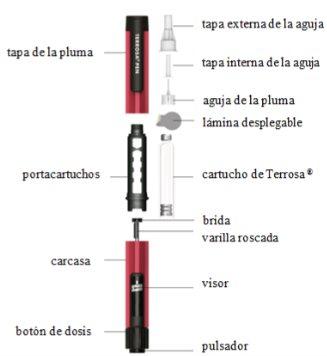
button; viewer; threaded rod; clip; Terrosa cartridge; foldable sheet; pen needle; inner needle cap; outer needle cap; pen cap; cartridge holder, dose button, casing
Preparing the Pen - First Use/Cartridge Change
Follow the instructions each time you insert a new Terrosa cartridge into the Terrosa Pen. Do not repeat this step before each daily injection, as you will not have enough Terrosa for 28 days.
Read the cartridge leaflet provided with the Terrosa cartridge.
A: Remove the pen cap.
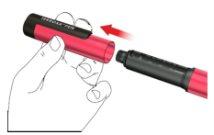
B: Turn the cartridge holder to remove it (bayonet fitting).
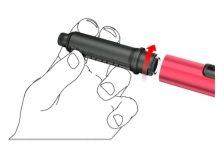
C: If you want to change the cartridge, remove the empty cartridge. Place a new Terrosa cartridge in the cartridge holder with the cartridge's metal foldable cap first.
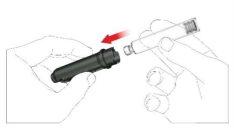
Note the date of the first injection of each new cartridge. This will help you know when the 28 daily doses per cartridge are finished.
D: Carefully push the threaded rod straight in with your finger until it stops. This is not necessary when the rod is already in the initial position, such as the first time you use it. The threaded rod cannot be fully inserted into the pen casing.
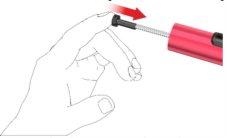
E: Attach the cartridge holder to the casing by turning it 90 degrees until it stops.
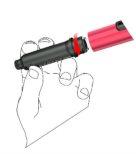
F: Attach a new pen needle as follows:
- Remove the foldable sheet.
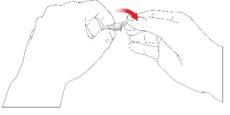
- Screw the pen needle clockwise into the cartridge holder. Make sure the pen needle is properly seated and firmly supported on the cartridge holder.
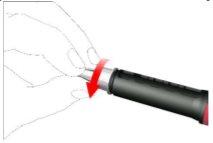
- Remove the outer needle cap and store it.
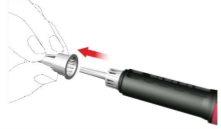
- Remove and discard the inner needle cap.
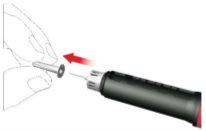
When attaching the needle, a few drops may escape; this is normal.
G: Priming
The pen must be primed and tested before inserting a new cartridge and before the first injection of each cartridge.
- Turn the dose button clockwise until you see the drop symbol in the dose viewer. Make sure the two lines of the indicator are aligned. During dose adjustment, the pen emits a click and offers a perceptible resistance.
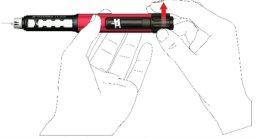
- Hold the pen with the needle pointing upwards.
- Press the button until the dose indicator returns to its initial position. Hold it pressed until a few drops of the medication come out of the needle tip.
If not, repeat step G until you see a few drops. Do not repeat step G more than four times; if necessary, follow the instructions in the Troubleshooting section on the back.
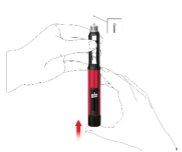
Administration using the Terrosa Pen
Wash your hands with soap carefully to reduce the risk of infection.
Make sure you have:
- the Terrosa Pen with the cartridge inserted
- a pen needle compatible with the pen
- a puncture-resistant container for used needles.
Do not usethe pen if the cartridge is cloudy or colored or contains particles.
Read the cartridge leaflet provided with the Terrosa cartridge.
- Attach the pen needle
Use a new needle for each injection. Do not use the pen needle if the packaging is damaged or you did not open it.
Note:it is not necessary to change the needle when using immediately after preparing the pen. In this case, continue with the "2. Dose adjustment and injection" step.
- Remove the foldable sheet.
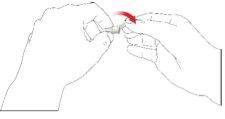
- Screw the pen needle clockwise into the cartridge holder. Make sure the pen needle is properly seated and firmly supported on the cartridge holder.
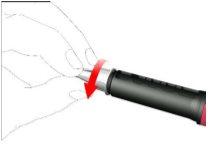
- Remove the outer needle cap and store it.
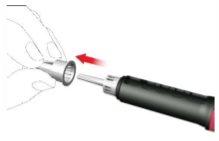
- Remove and discard the inner needle cap.
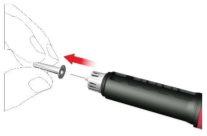
When attaching the needle, a few drops may escape; this is normal.
- Dose adjustment and injection
Warning: make sure to use the correct medication liquid. Check the cartridge label before inserting it into the cartridge holder.
- To adjust the fixed daily dose of 80 microliters, turn the dose button clockwise until it stops and cannot be turned further. Make sure the viewer shows an arrow symbol and the two lines of the indicator are aligned. During dose adjustment, the pen emits a click and offers a perceptible resistance. Do not try to force the dose button.
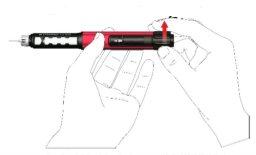
Note:if the cartridge contains less than 80 microliters, the dose button cannot be turned clockwise to the arrow symbol. In this case, remove the pen cap, change the cartridge, and prime it by following the pen preparation steps.
- Choose a suitable injection site and prepare the skin according to the doctor's recommendations. Carefully take a skin fold between the index and thumb fingers. Insert the pen needle straight and carefully into the skin, as shown in the illustration.
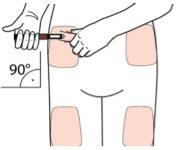
Warning:avoid bending or breaking the pen needle. Do not tilt the pen after inserting the needle into the skin. Tilt the pen can bend or break the needle. Broken needles can remain stuck in the skin. If a broken needle remains stuck in the skin, consult a doctor immediately.
- Press the button until the dose indicator returns to its initial position. Leave the needle in the skin fold for 6 seconds more.
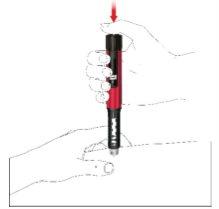
- Slowly pull out the pen. Check if the viewer is in the initial position to ensure that the full dose has been injected.
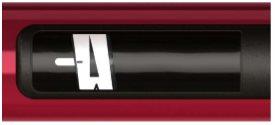
- Removing the needle from the pen
- Carefully place the outer needle cap over the pen needle.
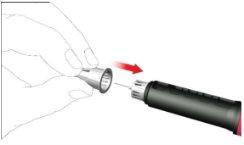
- Screw the needle cap counterclockwise to remove the needle from the pen. Dispose of it properly, for example in a puncture-resistant container.
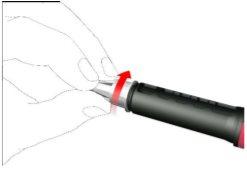
- Replacing the pen cap
- Do not remove the cartridge from the Terrosa Pen before it is empty.
- Replace the pen cap after each use.
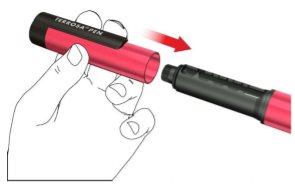
- Put the Terrosa Pen with the cartridge in the refrigerator at a temperature of 2 to 8 °C immediately after use.
Note for Healthcare Professionals
Local, healthcare professional, or institutional policies may replace the instructions regarding needle handling and disposal.
Additional Information
The reusable fixed-dose pen is designed for easy administration of Terrosa to treat osteoporosis. Each Terrosa cartridge contains 28 fixed doses of 80 microliters of Terrosa.
Use the Terrosa Pen only as directed by your doctor and according to the information in these instructions for use and the Terrosa cartridge leaflet.
The Terrosa Pen can be used by patients who self-inject and are over 18 years of age, healthcare professionals, or third parties such as adult family members.
The Terrosa Pen should not be used by blind or visually impaired patients without the help of a physically able and properly trained person. Consult your doctor if you have hearing or handling problems.
If you have any questions about using the Terrosa Pen, contact our customer serviceat any time.
Phone number: XXXXXXXXXXX
Email: XXXXXXXXXXX
Pen-compatible needles
- Ypsomed mylife Clickfine, gauge 29 to 31 (diameter 0.25 - 0.33 mm) and length of 12, 10, 8 or 6 mm
- BD Micro-Fine Ultra pen needles, gauge 29 to 31 (diameter 0.25 - 0.33 mm) and length of 12.7, 8 or 5 mm
Pen needles from other manufacturers may be used according to the compatibility details indicated.
Pen needles must be used only onceand only one person should use the Terrosa cartridge.
Storage and Care of the Terrosa Pen
- Handle the pen carefully. Do not drop the pen and avoid hitting it against hard surfaces. Protect it from water, dust, and moisture.
- You can use a damp cloth to clean the Terrosa Pen. Do not use alcohol, solvents, or cleaning agents. Do not submerge the Terrosa Pen in water, as it may damage it.
- Do not use the Terrosa Pen if it is damaged or if you have doubts about its proper functioning.
- Transport and store the Terrosa Pen with the cartridge at the temperature indicated in the Terrosa cartridge leaflet provided separately.
- Keep the Terrosa Pen, cartridges, and needles out of the reach of children.
- Do not store the Terrosa Pen with the needle attached, as it may cause air bubbles to form in the cartridge.
How to Dispose of the Terrosa Pen and Used Accessories
The Terrosa Pen has a lifespan of two years. Before disposing of the Terrosa Pen, remove the needle and cartridge. Used needles and cartridges must be disposed of safely and separately. The Terrosa Pen can be disposed of according to local authority instructions.
Warnings
Follow the instructions presented in these instructions for use. Failure to follow these instructions may result in medication errors, inadequate dosing, disease transmission, or infection. If you have any health problems, seek medical attention immediately.
Warranty
The warranty covers material and manufacturing defects of the Terrosa Pen for two years of use from the date of purchase. It is limited to replacing the pen. The warranty does not cover damage caused by:
- using cartridges that are not Terrosa cartridges
- incorrect or negligent use, handling, or cleaning
- use contrary to the instructions for use
- using the pen with a medical device, accessory, or consumable other than those recommended by Gedeon Richter Plc.
- drops, shocks, application of force, contact with liquids
- other cases of exposure and wear that are not in accordance with the instructions for use.
Troubleshooting
If you have any questions about using the Terrosa Pen, follow the instructions given in the table on the next page:
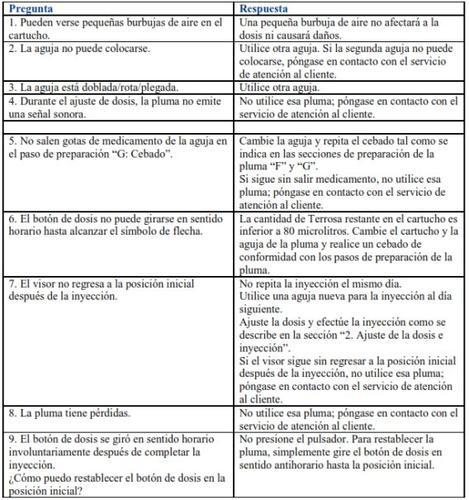
Distributor:
Gedeon Richter Plc.
Gyömroi út 19-21.
1103 Budapest, Hungary
Legal Manufacturer:
Ypsomed AG
Brunnmattstrasse 6
3401 Burgdorf, Switzerland
- Country of registration
- Active substance
- Prescription requiredYes
- Manufacturer
- This information is for reference only and does not constitute medical advice. Always consult a licensed doctor before taking any medication. Oladoctor is not responsible for medical decisions based on this content.
- Alternatives to TERROSA 20 micrograms/80 microliters Injectable SolutionDosage form: INJECTABLE, 250 micrograms/mlActive substance: teriparatideManufacturer: Gp Pharm S.A.Prescription requiredDosage form: INJECTABLE, 250 µg/mlActive substance: teriparatideManufacturer: Eli Lilly Nederland B.V.Prescription requiredDosage form: INJECTABLE, 20 micrograms/80 microlitersActive substance: teriparatideManufacturer: Theramex Ireland LimitedPrescription required
Alternatives to TERROSA 20 micrograms/80 microliters Injectable Solution in other countries
The best alternatives with the same active ingredient and therapeutic effect.
Alternative to TERROSA 20 micrograms/80 microliters Injectable Solution in Poland
Online doctors for TERROSA 20 micrograms/80 microliters Injectable Solution
Discuss dosage, side effects, interactions, contraindications, and prescription renewal for TERROSA 20 micrograms/80 microliters Injectable Solution – subject to medical assessment and local rules.










